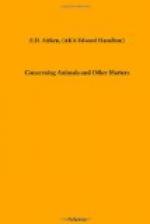When woman first looked at her face in a polished saucepan, she was at once struck with the comicality of those things, and bethought herself what to do with them. She decided to use them for pegs to hang ornaments on. The improvement excited the admiration of her husband and the envy of her rivals to such a degree that all other women of taste in her tribe did the same, and from that day to this, in almost every country in the world, it has been accounted a shame for any respectable woman to show her face in public in the hideousness of naked ears. This discovery of its capabilities gave a new value to the ear, and a large, roomy one became an asset in the marriage market. I have seen a pretty little damsel of Sind with fourteen jingling silver things hanging at regular intervals from the outside edge of each ear. If Nature had been niggardly, the lobe at least could be enlarged by boring it and thrusting in a small wooden peg, then a larger one, and so on until it could hold an ivory wheel as large as a quoit, and hung down to the shoulders.
But Nature surely did not intend the ear for this purpose. Then what did she intend? A popular error is that the ears are given to hear with, but the ears cannot hear. The hearing is done by a box of assorted instruments (malleus, incus, stapes, etc.) hidden in a burrow which has its entrance inside of the ear. If you argue that the ears are intended to catch sounds and direct them down to the hearing instrument, then explain their absurd shape. They are useless. A man who wants to hear distinctly puts his hand to his ear. And why do they not turn to meet the sounds that come from different quarters? They are absolutely immovable, and therefore also expressionless. A savage expresses his mind with all the rest of his face; he smiles and grins and pouts and frowns, but his ears stand like gravestones with the inscriptions effaced. How different is the case when you turn from man to the “irrational” animals! The eyes of a fawn are lustrous and beautiful, but they would be as meaningless as polished stones without the eloquent ears that stand behind them and tell her thoughts. Curiosity, suspicion, alarm, anger, submission, friendliness, every emotion that flits across her quick, sensitive mind speaks through them. They are in touch with her soul, and half the music of her life is played on them. And if you abstract yourself from individuals and look at that thing, the ear, in the wide field of life, what a great, living reality it is!—a spiritual unity under infinite diversity of material form and fashion. It is like the telegraph wire overhead, the commonest and plainest of material things, but charged with the silent and invisible currents of the life of the world.
“Let my heart be still a moment and this mystery explore.”
[Illustration: OR PERHAPS WHEN IT WANTS TO LISTEN IT RAISES A FLIPPER TO ITS EAR.]




